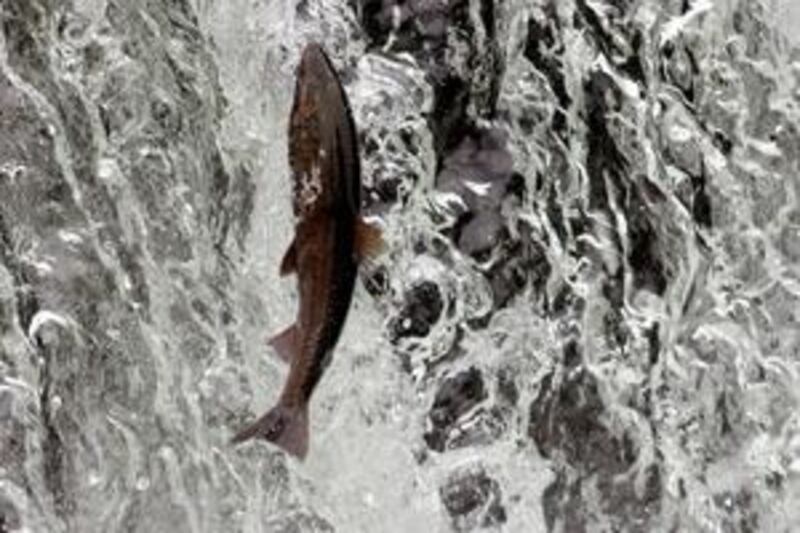I was relieved to learn that my friend Kris Webb - lawyer, novelist, activist, mother of three and a fabulous cook - didn't know more about salmon than I did. "My salmon choice amounts actually to whatever is on the shelf at Spinneys," she admitted when I asked about her preference for wild versus farmed, Atlantic versus Pacific. We were chatting about favourite recipes for salmon, a fish we both love for its flavour and versatility. Grilled in foil, baked in parchment, flaked in salad, sautéed in a pan with a bit of oil and butter - how can you go wrong? Salmon is the fish even people not wild about fish like.
"Salmon is a fantastic fish," agrees Peter Lonsdale, the operations manager for LuLu Hypermarkets. "It has great nutritional value and is not overly expensive. It's become very popular here, as popular as hammour or kingfish. And it's not just westerners. Customers from the Asian continent, expats from other Middle Eastern countries and the Emirates - everyone loves salmon." What we eat here in the UAE is wild salmon, right? No, Lonsdale gently corrects me. "Wild salmon is very hard to get nowadays and expensive. What we're buying and what you're eating is farmed salmon from Norway." Sixty to 70 per cent of the world's farmed salmon - about 570,000 tonnes per year - comes from Norwegian fjords that have strong tidal flows, he explains. (Norwegian salmon is also called Atlantic salmon.) "Fish must be in fast-flowing fresh water. This creates a stronger fish because the movement of swimming builds muscle, which translates into better flesh."
But I seem to remember some bad press about farmed salmon. A thing of the past, Lonsdale reassures me. "Long gone are the days where you have intensive farming. Now the fish arrive in beautiful shape, their tails intact." Too many fish in too small an area, Lonsdale explains, used to result in their fins getting damaged. Sometimes, too, there were parasites. "But those practices are long behind us. Now we have less fish in more space."
Lonsdale divests me of another notion when I express my preference for salmon with no fat. "A fat-free salmon is a lazy salmon," he laughs. "It's not swimming enough." So a strong-swimming salmon is marbled with fat? It's not like us humans then: the more we exercise the leaner we are. You don't want a lot of fat either, he clarifies. "What you need to look for is a nice, even pink throughout the fillet and skin with no discolouration."
Kris Webb likes making these midweek for her family: "Yummy, healthy and quick to throw together." The original recipe from Australian Gourmet Traveller called for smoked salmon, but Webb put her own spin on these heavenly croquettes, adding a flaked, cooked salmon fillet to the mixture. "It made it more nourishing and we like the combination of fresh and smoked." I slathered these with homemade dill aioli, but Webb prefers a good chilli sauce. Makes 18-20 (6cm) cakes.
Ingredients 3 medium-large potatoes 300g salmon fillet 5ml vegetable oil 5ml butter 300g smoked salmon 5g parsley, finely chopped 3 green onions, finely chopped 15ml dill, finely chopped 3 eggs 125g breadcrumbs 30ml vegetable oil 30ml butter Method Peel and quarter the potatoes and boil in salted water until almost cooked (about 10 minutes). Cool, then grate the potatoes and place in a large bowl. Melt the butter and oil in a frying pan and pan-fry the salmon fillet until done. (About 10 minutes on each side. Check the centre for doneness.) Place the fillet on a plate and finely flake with a fork and knife. Add the salmon to the bowl of grated potatoes. Finely chop the smoked salmon and add to the mixture. Add the chopped herbs: parsley, green onions and dill. Mix well (clean hands work best). Form the salmon-potato mixture into patties (approximately 1cm thick and 6cm in diameter) and place them on a baking sheet lined with wax paper.
Lightly beat three eggs in a small bowl. Put breadcrumbs in another small bowl. Dip each patty in first the beaten egg, then coat in the bowl of breadcrumbs. Place each patty back on the baking sheet. Continue until all the patties are breaded. Melt the butter and oil in a frying pan over medium-high heat. Working three or four at a time, cook the patties until they're brown and crunchy, about two minutes on each side. Serve with homemade dill aioli or chilli sauce.






